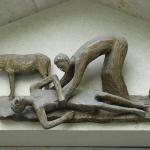…don’t seem to be in a big hurry to practice this form of Buddhism. Eastern religion is, for most Westerners, about accessorizing, not about serious life change.
The Prophet Chesterton (who once observed that, for our elites, Christianity and Buddhism are the same, especially Christianity) writes about the popular notions of “harsh Christian ascetism” that dominate the minds of people who know nothing about harsh ascetism in his wonderful book St. Thomas Aquinas: The Dumb Ox:
The ordinary modern critic, seeing this ascetic ideal in an authoritative Church, and not seeing it in most other inhabitants of Brixton or Brighton, is apt to say, “This is the result of Authority; it would be better to have Religion without Authority.” But in truth, a wider experience outside Brixton or Brighton would reveal the mistake. It is rare to find a fasting alderman or a Trappist politician, but it is still more rare to see nuns suspended in the air on hooks or spikes; it is unusual for a Catholic Evidence Guild orator in Hyde Park to begin his speech by gashing himself all over with knives; a stranger calling at an ordinary presbytery will seldom find the parish priest lying on the floor with a fire lighted on his chest and scorching him while he utters spiritual ejaculations. Yet all these things are done all over Asia, for instance, by voluntary enthusiasts acting solely on the great impulse of Religion; of Religion, in their case, not commonly imposed by any immediate Authority; and certainly not imposed by this particular Authority. In short, a real knowledge of mankind will tell anybody that Religion is a very terrible thing; that it is truly a raging fire, and that Authority is often quite as much needed to restrain it as to impose it. Asceticism, or the war with the appetites, is itself an appetite. It can never be eliminated from among the strange ambitions of Man. But it can be kept in some reasonable control; and it is indulged in much saner proportion under Catholic Authority than in Pagan or Puritan anarchy. Meanwhile, the whole of this ideal, though an essential part of Catholic idealism when it is understood, is in some ways entirely a side issue. It is not the primary principle of Catholic philosophy; it is only a particular deduction from Catholic ethics. And when we begin to talk about primary philosophy, we realise the full and flat contradiction between the monk fasting and the fakir hanging himself on hooks.
Now nobody will begin to understand the Thomist philosophy, or indeed the Catholic philosophy, who does not realise that the primary and fundamental part of it is entirely the praise of Life, the praise of Being, the praise of God as the Creator of the World. Everything else follows a long way after that, being conditioned by various complications like the Fall or the vocation of heroes. The trouble occurs because the Catholic mind moves upon two planes; that of the Creation and that of the Fall. The nearest parallel is, for instance, that of England invaded; there might be strict martial law in Kent because the enemy had landed in Kent, and relative liberty in Hereford; but this would not affect the affection of an English patriot for Hereford or Kent, and strategic caution in Kent would not affect the love of Kent. For the love of England would remain, both of the parts to be redeemed by discipline and the parts to be enjoyed in liberty. Any extreme of Catholic asceticism is a wise, or unwise, precaution against the evil of the Fall; it is never a doubt about the good of the Creation. And that is where it really does differ, nor only from the rather excessive eccentricity of the gentleman who hangs himself on hooks, but from the whole cosmic theory which is the hook on which he hangs. In the case of many Oriental religions, it really is true that the asceticism is pessimism; that the ascetic tortures himself to death out of an abstract hatred of life; that he does nor merely mean to control Nature as he should, but to contradict Nature as much as he can. And though it takes a milder form than hooks in millions of the religious populations of Asia, it is a fact far too little realised, that the dogma of the denial of life does really rule as a first principal on so vast a scale. One historic form it took was that great enemy of Christianity from its beginnings: the Manichees.
What is called the Manichean philosophy has had many forms; indeed it has attacked what is immortal and immutable with a very curious kind of immortal mutability. It is like the legend of the magician who turns himself into a snake or a cloud; and the whole has that nameless note of irresponsibility, which belongs to much of the metaphysics and morals of Asia, from which the Manichean mystery came. But it is always in one way or another a notion that nature is evil; or that evil is at least rooted in nature. The essential point is that as evil has roots in nature, so it has rights in nature. Wrong has as much right to exist as right. As already stated this notion took many forms. Sometimes it was a dualism, which made evil an equal partner with good; so that neither could be called an usurper. More often it was a general idea that demons had made the material world, and if there were any good spirits, they were concerned only with the spiritual world. Later, again, it took the form of Calvinism, which held that God had indeed made the world, but in a special sense, made the evil as well as the good: had made an evil will as well as an evil world. On this view, if a man chooses to damn his soul alive, he is not thwarting God’s will but rather fulfilling it. In these two forms, of the early Gnosticism and the later Calvinism, we see the superficial variety and fundamental unity of Manicheanism. The old Manicheans taught that Saran originated the whole work of creation commonly attributed to God. The new Calvinists taught that God originates the whole work of damnation commonly attributed to Satan. One looked back to the first day when a devil acted like a god, the other looked forward to a last day when a god acted like a devil. But both had the idea that the creator of the earth was primarily the creator of the evil, whether we call him a devil or a god.
Since there are a good many Manicheans among the Moderns, as we may remark in a moment, some may agree with this view, some may be puzzled about it, some may only be puzzled about why we should object to it. To understand the medieval controversy, a word must be said of the Catholic doctrine, which is as modern as it is medieval. That “God looked on all things and saw that they were good” contains a subtlety which the popular pessimist cannot follow, or is too hasty to notice. It is the thesis that there are no bad things, but only bad uses of things. If you will, there are no bad things but only bad thoughts; and especially bad intentions. Only Calvinists can really believe that hell is paved with good intentions. That is exactly the one thing it cannot be paved with. But it is possible to have bad intentions about good things; and good things, like the world and the flesh have been twisted by a bad intention called the devil. But he cannot make things bad; they remain as on the first day of creation. The work of heaven alone was material; the making of a material world. The work of hell is entirely spiritual.











